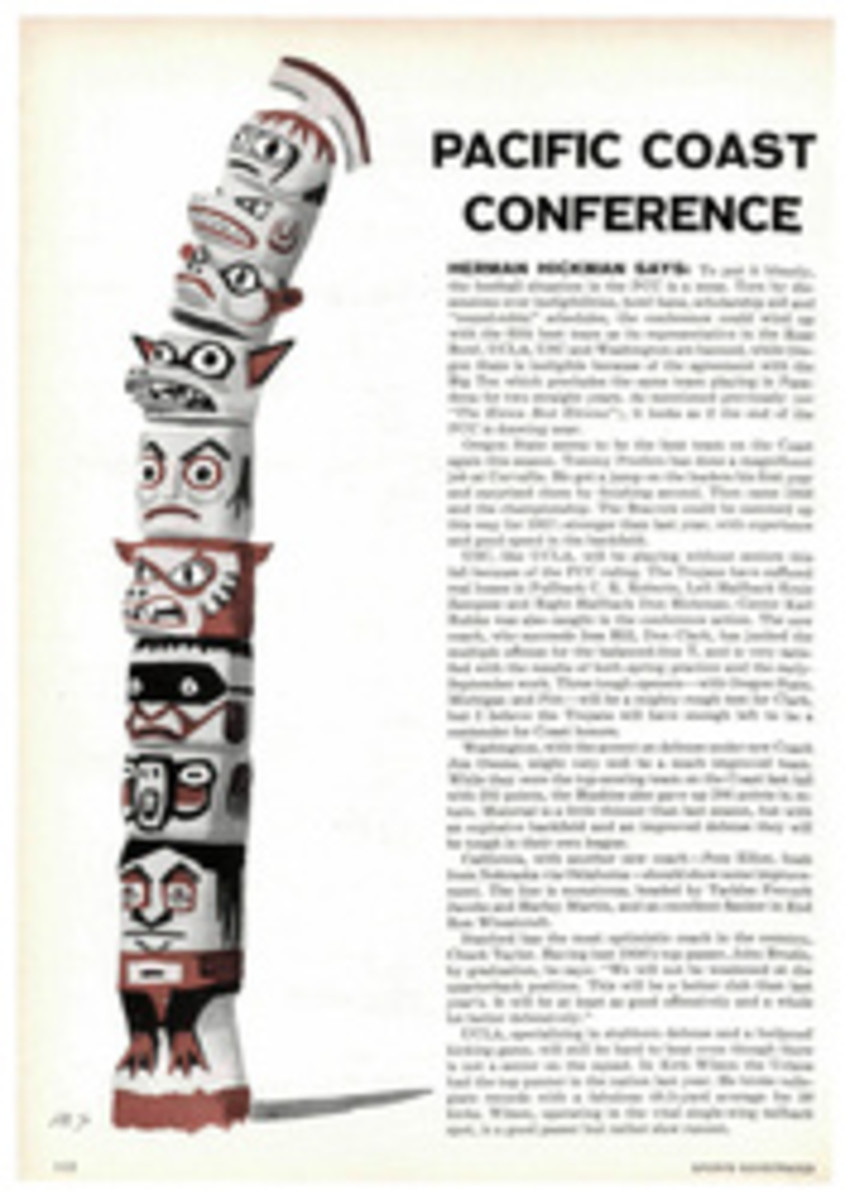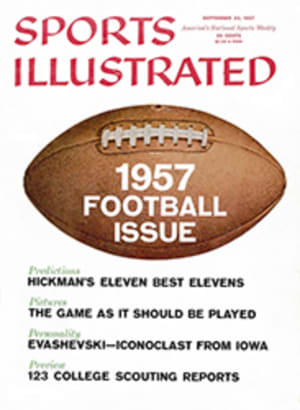
THE ELEVEN BEST ELEVENS
What a difference a few years make! The Two Platoonists are now just a memory, and the subsequent grind-it-out football of the split-T era is fast dying. The arm is coming back to the collegiate game, and there is even a faint rumor in some sections that the "foot" may return to football. Another revival from the past is the old game maxim: "Against equal opposition, a drive of more than 50 yards is seldom successful." The eight- and nine-man lines put a stop—as predicted last year—to the doctrine: "All we want is the ball. We'll grind it out chunk by chunk and yard by yard." And I say good riddance.
Once again innovation rears its head, and Football 1957 will be the more exciting for it. The static split-T, long ago discarded in fundamental form by its earliest and foremost protagonists, is being converted into more elastic offensive maneuvers. Thus, the packed defenses of this fading era will be challenged by a more open style of play.
Of paramount importance in today's football is the all-round player, and that is as it should be. Just "good run, no tackle" does not fit the present picture of a top-flight football player. Defensive ability has become a prime requisite in picking the starting eleven by some of the country's outstanding college coaches.
The two-unit system, with the players going both ways, continues to grow in popularity. Few of the nation's leading teams attempt to operate without "A" and "B" units alternating at planned intervals. While the specialist era was ended by rule-book legislation, the 60-minute player has been outmoded by the faster tempo of the modern game.
Sometimes we oldtimers brag about our "iron man" exploits when men were men and a substitute was an insult except for broken bones but, let's face it, we didn't play the same kind of game, even 25 years ago. There is nothing so disillusioning as viewing films of games in the early days. For the most part it was push and pull, built around a wedge attack up the middle. A mousetrap was still an implement for catching mice; downfield blocking was a myth and if a defensive man tackled above the knees he was considered yellow. Then came that dastardly innovation, the forward pass, and football coaching became a profession.
And speaking of the coach, his attitude toward the coming season has—for the most part—become mighty refreshing by comparison with the Gloomy Gus of yesteryear. I like the tongue-in-cheek statement of Michigan State's Duffy Daugherty: "With a legion of lettermen returning we should have a great season if the coaches come through." Or what Jim Myers, new coach at Iowa State, long the door mat of the conference, told me recently: "Oklahoma is so scared of us that they have an open date the week before our game in order to get ready." Red Sanders, whose UCLA squad has been wrecked by the Pacific Coast Conference eligibility ruling, put it most succinctly when asked about this season's prospects: "Just like the situation at Oklahoma, Tennessee, Georgia Tech, Iowa or any other top university if you took away all the seniors."
On the administrative side long strides have been taken in the right direction by almost everyone—except the Pacific Coast Conference—toward a more realistic approach to the problems of scholarship aid and recruiting. The Big Ten adopted a new code almost exactly in line with the Nine Points For Survival advocated by me in the August 13, 1956 issue of SPORTS ILLUSTRATED. One particularly important aspect of this code is the inclusion of the "show-need" provision for granting aid to prospective athletes.
This clause is a sore spot in several of the Big Ten institutions and has been roundly ridiculed by many of my friends and former coaching compatriots in other sections. It has been called "an invasion of privacy" and "unworkable," but it has worked for years in the Ivy League as a criterion for scholarship aid to all students and I believe it will be adopted by most conferences as an integral part of the scholarship aid formula within the next few years.
The soft September schedule is a thing of the past. Most of the colleges go into action on the weekend of September 21, with the exception of the Big Ten and the Ivy League, who follow the next Saturday. Conference and national rankings could be decided early. Six of my Eleven Elevens play the first Saturday against major opponents. Perhaps the most important of these, from a national standpoint, is Oklahoma, putting its 40 straight victories on the line against Pittsburgh in Pitt Stadium. The powerful Panthers have a chance to make history, but the Sooners know this.
From a prognosticator's standpoint—particularly this one's—the Georgia Tech-Kentucky opener at Atlanta is even more important. Against all reason, according to my compatriots, I picked Tech, as usual, on my Eleven Elevens despite the fact that its first two teams have been decimated by graduation. The Wildcats are lean and hungry, while the Yellow Jackets are young. This affair, incidentally, is only the matinee at Grant Field. Georgia plays Texas that night.
Here are some added thoughts on the selection of my Eleven Elevens. There are some teams, such as Utah in the Skyline Conference, which may finish with better won-and-lost records than my personal choices for top honors, just as Wyoming did last season. But it is my belief that the caliber of competition is not quite strong enough in some of those areas to justify rating the leading teams among the country's best. Seven of the Eleven Elevens use some type of T, split-T, or wing T, with balanced line. These are Oklahoma, Texas A&M, Baylor, Georgia Tech, Minnesota, Navy and Penn State. The Tennessee type of balanced-line single wing, with the accent on double blocking, is used exclusively by Tennessee and Oregon State. Both Michigan State and Michigan use the multiple offense, aligning in an unbalanced-line T, running plays from this pre-shift formation or shifting to some variation of an unbalanced-line single wing. Listing the teams alphabetically and not in order of their strength, here are some comments on my selections for 1957:
Baylor. Two best and biggest lines in the Southwest, possibly in the country. Will miss graduated defensive secondary strength.
Georgia Tech. Well-nourished and trained reserve strength, although untried under fire. Perfectly planned kicking game and winning ways. May come late.
Michigan. Always on or near the top. Graduation losses were heavy in the line, but backfield is dangerous.
Michigan State. Well-fortified at all positions, same as last season, but cannot possibly have as bad luck with key injuries.
Minnesota. Gophers have best material since Bierman. Will need it with eight conference games and some of the tougher ones on the road. Team needs breakaway runners, but has Quarterback Bobby Cox, one of those superb players who comes along at rare moments.
Navy. Experience at every position in two-team depth. Good defense coupled with wide-open pro-type offensive play.
Oklahoma. Fast, slashing, aggressive play built on speed and quick reaction. Abundant material and high morale make them a permanent winner.
Oregon State. Arrived a year early but should be even better this season. Fine outside running strength. Need depth at vital tailback spot.
Penn State. Good depth and experience due to judicial use of two balanced units in 1956. Excellent running game and sharp passing. Season hinges on Army game first week in October.
Tennessee. Outstanding backfield. Line may be a little light. Hard blocking and determined defensive play, with accent on kicking game, make Vols a hard team to beat.
Texas A&M. Tough-fibered, well-drilled squad. Features hard-running and aggressive defensive play. Some internal line weaknesses.
You will notice many old familiar names on the Eleven Elevens. Some are missing such as Army, Miami, Notre Dame, Duke, Ohio State and Iowa, and for any or all of these deletions I may be sorry. Strong powers in the Southeastern Conference such as Auburn and Kentucky may wreck Tech and Tennessee. Miami, despite sworn statements to the contrary by my old Army coaching confrere, Andy Gustafson, may again be among the top teams. Give Notre Dame opening victories over Purdue and Indiana, and the Irish too will be hard to halt. To new faces on the Eleven Elevens—Minnesota, Baylor, Tennessee, Oregon State and Penn State—Welcome! And may all your troubles be big wins.
The sounds of the practice field can be heard throughout the land: the muted staccato of shoulder and hip pads against blocking dummies; the thud of leather foot meeting football; the rhythmic "Ready! Get Set! 1-2, 1-2" of the quarterback; the shrill whistle; the coaches' "All Up!"
America is ready. Football is here.
[originallink:10478301:43535]
In the Scouting Reports following, this insignia indicates the team is one of Hickman's choices.
Something to PASTE IN YOUR HAT
A fashion show capable of dwarfing the action on the field is scheduled for October 19, when Maryland plays North Carolina before Queen Elizabeth and Prince Philip. North Carolinians plan to wear cutaways, striped trousers and toppers; as they enter the stadium at College Park they will sing God Save the Queen and then hoist a toast to Her Majesty.
The human knee is just not suitable for modern football. Before every scrimmage at Iowa, 23 knees must be taped for support—at an annual cost of $1,075.50. And Iowa is by no means exceptional among major colleges in this respect.
Buttons for substitutes is an innovation being tried this year by the Southwest Conference in order to ease the burden on officials. When a player enters the game, he gives the referee a button with his number on it. Since a player can enter the game only once in each quarter, he obviously cannot reenter if his button is used. At the end of each quarter, the referee returns the used buttons to each team, and the whole thing starts all over again.
Memphis State is a team to watch. The Tigers would like to get downtown businessmen to contribute to a scholarship fund and thus bring big-time football to a city that has none.
Coach Earl Blaik, of Army, is limiting his first squad to 34 men during practice sessions—instead of the usual 50 or 60. He says they are the 34 who can do him the most good and he wants to give them his closest attention.
Due to Louisiana segregation laws, the Army-Tulane game, scheduled for New Orleans Nov. 16, has been transferred to West Point by Army Secretary Wilber Brucker so that folks who want to go may sit where they please.

